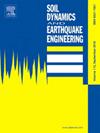量化RC桥弯震后残余竖向承载能力:可解释机器学习模型的参数化研究与开发
IF 4.2
2区 工程技术
Q1 ENGINEERING, GEOLOGICAL
引用次数: 0
摘要
桥梁弯道的震后残余竖向承载能力(VLCC)是衡量桥梁承载地震后交通荷载的功能指标,直接关系到桥梁的抗震能力。为了促进下一代基于弹性的桥梁抗震设计,本研究系统地量化了广泛采用的钢筋混凝土(RC)单柱和双柱桥梁弯曲的震后残余VLCC。采用由两相循环推覆分析和推覆分析(即竖向向下推覆)组成的分析框架,对桥梁弯折的震后残余VLCC进行了评价。采用经过验证的数值模拟技术进行了深入的参数化研究,量化了地震后VLCC的退化,同时探讨了弯曲结构参数对其的影响。此外,还收集了包含860个震后残余VLCC结果的数据集,进行了统计分析,并应用于开发可解释的机器学习(ML)预测模型。研究发现,VLCC的退化是地震荷载作用下RC材料的物理损伤和竖向荷载作用下残余变形P-Δ效应的综合作用。在设计损伤状态下,单柱和双柱弯道的平均残余VLCC分别达到原始水平的89.1%和95.7%。所建立的ML模型可以合理地预测桥梁弯曲的震后残余VLCC,误差在20%以内,其解释结果与数据集的参数研究和统计分析结果一致。本文章由计算机程序翻译,如有差异,请以英文原文为准。
Quantifying post-earthquake residual vertical load-carrying capacity (VLCC) of RC bridge bents: Parametric study and development of interpretable machine learning models
The post-earthquake residual vertical load-carrying capacity (VLCC) of bridge bents serves as a measure of bridge functionality to carry traffic loads following earthquake events, which is directly associated with the seismic resilience of bridges. To facilitate the next-generation resilience-based seismic design of bridges, this study systematically quantifies the post-earthquake residual VLCC of widely adopted reinforced concrete (RC) single-column and double-column bridge bents. An analytical framework comprising two-phase cyclic pushover analyses followed by pushdown analyses (i.e., pushover in the vertical-downward direction) is applied to evaluate the post-earthquake residual VLCC of bridge bents. An in-depth parametric study is conducted using validated numerical modeling techniques to quantify the VLCC degradation following earthquakes, and meanwhile, to explore how it is affected by bent structural parameters. Additionally, a dataset containing a total number of 860 post-earthquake residual VLCC results is gathered, statistically analyzed, and applied to develop interpretable machine learning (ML) predictive models. It is found that the degradation of VLCC can be attributed to a combination effect of physical damage to RC materials during the seismic loading and post-earthquake residual deformation-associated P-Δ effect during the vertical loading. At the design damage state that half of the inelastic deformation capacity of bents is mobilized, the mean residual VLCC of single-column and double-column bents reaches 89.1 % and 95.7 % of the original level, respectively. The developed ML models can provide reasonable predictions of the post-earthquake residual VLCC for bridge bents with errors mostly within 20 % and provide interpretation results align with the findings from the parametric study and statistical analysis of the dataset.
求助全文
通过发布文献求助,成功后即可免费获取论文全文。
去求助
来源期刊

Soil Dynamics and Earthquake Engineering
工程技术-地球科学综合
CiteScore
7.50
自引率
15.00%
发文量
446
审稿时长
8 months
期刊介绍:
The journal aims to encourage and enhance the role of mechanics and other disciplines as they relate to earthquake engineering by providing opportunities for the publication of the work of applied mathematicians, engineers and other applied scientists involved in solving problems closely related to the field of earthquake engineering and geotechnical earthquake engineering.
Emphasis is placed on new concepts and techniques, but case histories will also be published if they enhance the presentation and understanding of new technical concepts.
 求助内容:
求助内容: 应助结果提醒方式:
应助结果提醒方式:


